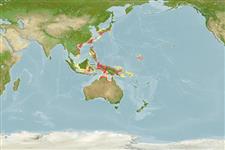>
Anguilliformes (Eels and morays) >
Muraenidae (Moray eels) > Muraeninae
Etymology: Gymnothorax: Greek, gymnos = naked + Greek, thorax, -akos = breast (Ref. 45335).
More on author: Snyder.
Environment: milieu / climate zone / depth range / distribution range
বাস্তুসংস্থান
সামুদ্রিক রীফ সংশ্লিষ্ট; গভীরতার পরিসীমা 5 - 30 m (Ref. 90102). Subtropical
Western Pacific: Ryukyu Islands, the Philippines, and Indonesia (Ref. 27470); Taiwan (Ref. 6934).
আকৃতি / ওজন / Age
Maturity: Lm ? range ? - ? cm
Max length : 60.0 cm TL পুরুষ/ লিঙ্গ অনিধর্ারিত ; (Ref. 559)
Body with broad black bands (Ref. 48635).
Occurs in coastal sand and mud habitat, living in holes near rubble or reef (Ref. 48635).
Life cycle and mating behavior
Maturities | প্রজনন | Spawnings | Egg(s) | Fecundities | শুককীট
Masuda, H., K. Amaoka, C. Araga, T. Uyeno and T. Yoshino, 1984. The fishes of the Japanese Archipelago. Vol. 1. Tokai University Press, Tokyo, Japan. 437 p. (text). (Ref. 559)
IUCN Red List Status (Ref. 130435)
Threat to humans
Harmless
Human uses
মৎস্য: গৌণ বাণিজ্যিক
হাতিয়ার
Special reports
Download XML
ইন্টারনেট সুত্র
Estimates based on models
Preferred temperature (Ref.
123201): 23.5 - 29.3, mean 28.6 °C (based on 993 cells).
Phylogenetic diversity index (Ref.
82804): PD
50 = 0.5000 [Uniqueness, from 0.5 = low to 2.0 = high].
Bayesian length-weight: a=0.00047 (0.00025 - 0.00089), b=3.28 (3.13 - 3.43), in cm total length, based on LWR estimates for this Genus-body shape (Ref.
93245).
ট্রফিক পর্যায়ে (Ref.
69278): 4.0 ±0.6 se; based on size and trophs of closest relatives
স্থিতিস্থাপক (Ref.
120179): মাধ্যম , সর্বনিম্ন প্রজন দ্বিগুনের সময় ১.৪-৪.৪ বৎসর (Preliminary K or Fecundity.).
Fishing Vulnerability (Ref.
59153): Moderate vulnerability (44 of 100).
